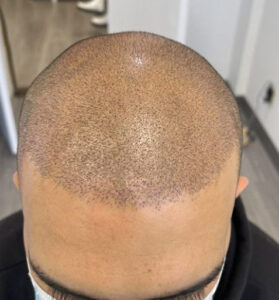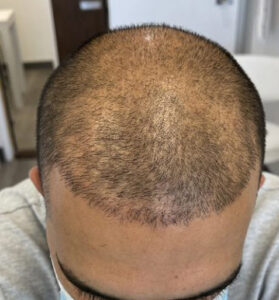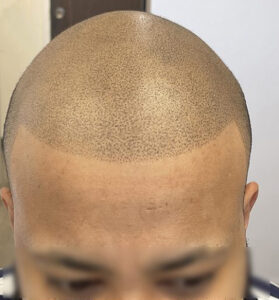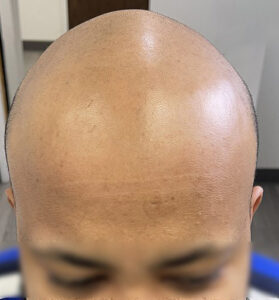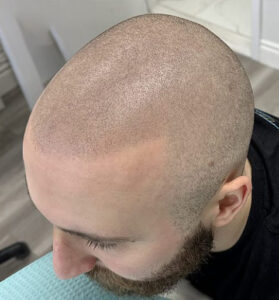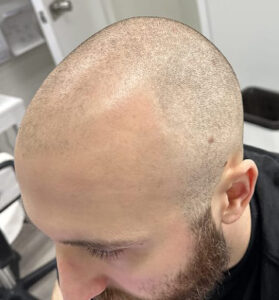PRP Hair Treatment

Introduction to PRP Hair Treatment
What is PRP Hair Treatment?
Platelet-rich plasma (PRP) hair treatment represents a state-of-the-art solution for individuals facing hair loss.
This advanced method uses the patient’s blood to enhance hair growth, providing a natural technique that greatly minimizes the risk of allergic reactions and ensures compatibility. PRP is particularly effective in addressing prevalent issues such as androgenetic alopecia (both male and female pattern baldness) and alopecia areata. The process entails drawing a minimal amount of blood from the patient’s arm and then processing it to enhance the concentration of platelets. These platelets are critical as they are rich in growth factors that promote hair follicle recovery and stimulate new hair growth.
Book Your Free Consultation Today Or Call (647)-492-5022
The Science Behind PRP Treatment
The efficacy of PRP stems from its high concentration of platelets, which naturally contain growth factors like Platelet-Derived Growth Factor (PDGF), Vascular Endothelial Growth Factor (VEGF), and Insulin-like Growth Factor (IGF). These factors are essential for hair follicle rejuvenation and the stimulation of new blood vessels, which help increase the blood supply to the treated areas, enhancing the health and thickness of the hair follicles.
A recent study indicated that PRP treatments might improve hair count and thickness while reducing hair loss without significant risks. Clinical trials persist in exploring the long-term effects and advantages of PRP therapy, with numerous case studies underscoring the positive results in hair density and recovery rate from hair loss.
How PRP Hair Treatment Works
Extraction Process of PRP
The extraction of PRP begins with a simple blood draw from the patient’s arm. The gathered blood sample is then placed into a centrifuge, which spins at high velocities. This process separates the blood components and allows for plasma extraction with a high concentration of platelets. This autologous preparation of platelets is crucial as it is free from foreign substances, reducing the chance of adverse effects.
Injection of PRP into Scalp
Once the platelet-rich plasma is ready, it is directly injected into the scalp regions experiencing hair thinning or loss.
Local anesthesia is often applied to the scalp to minimize discomfort during the procedure. The entire process of injecting PRP is meticulous and requires the expertise of board-certified dermatologists or trained medical personnel. This step is part of a three-step process that may need to be repeated several times for best results, typically spaced several weeks apart.
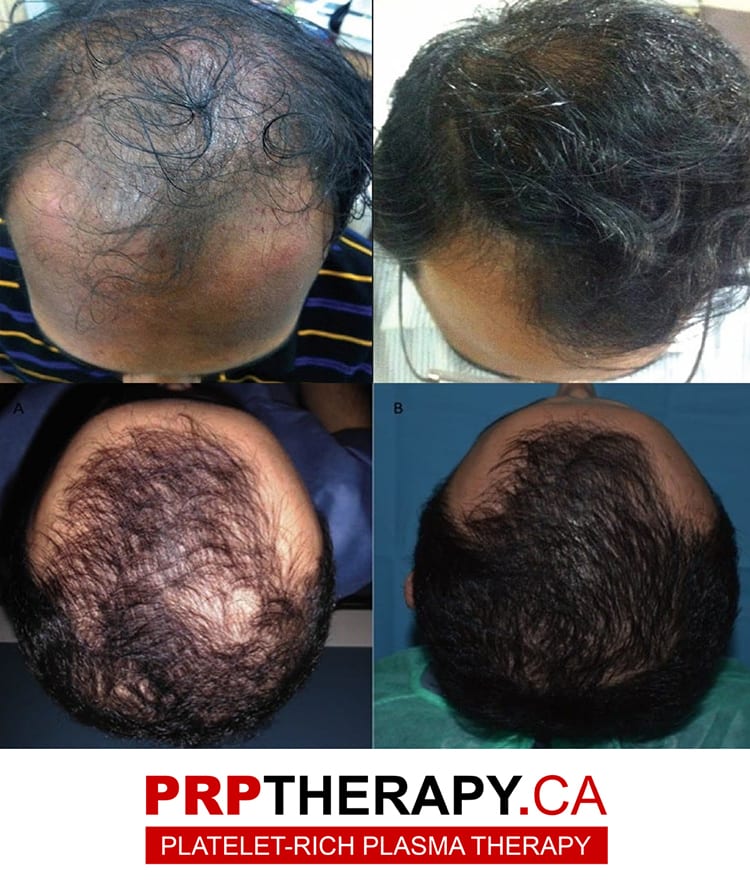
Benefits of PRP Hair Treatment
Increase in Hair Density
One of the primary benefits observed with PRP hair treatment is a significant increase in hair density. Clients often notice a difference in the fullness and appearance of their hair after just the first round of treatments. This improvement results from the activation of dormant hair follicles, contributing to an overall increase in hair count.
Improvement of Hair Quality
The quality of hair also improves dramatically with PRP treatments. The rich plasma helps thicken and thin hair and contributes to its lustre and vitality. It’s a favoured treatment among patients who prefer a non-surgical approach to hair restoration.
Recovery Speed of Hair Loss
Another crucial advantage of PRP therapy is its speed of recovery from hair loss conditions. Many patients report seeing initial results in as little as a few weeks, with gradual improvement over months. The natural stimulation of hair follicles leads to sustainable hair growth, offering a long-term solution to hair loss.
The PRP Procedure
Pre-procedure Steps
Before undergoing PRP hair treatment, patients are carefully evaluated by a doctor to ensure they are good candidates for this therapy. The pre-procedure steps typically involve:
- A detailed assessment of the patient’s medical status.
- A review of their hair loss areas.
- A discussion about their expectations and potential treatment outcomes.
Patients must avoid medications that can affect blood coagulating properties, such as aspirin and anti-inflammatory drugs, for a few days before the procedure. Additionally, doctors often recommend staying hydrated and eating a healthy meal before undergoing the blood draw.

The Actual PRP Treatment Process
The PRP treatment consists of a three-step process that typically takes about an hour to complete. Initially, a small amount of the patient was drawn from the patient’s arm. This blood is then transferred into a centrifuge, which rotates to segregate the plasma from the red and white blood cells. The resulting concentrated serum of platelets, enriched with growth factors, is then prepared for injection. Using a fine needle, the PRP is delivered into specific scalp regions where hair loss occurs. This technique focuses on the follicular units to increase hair thickness and encourage regrowth.
Post-procedure Care
After the PRP injections, patients may return to their normal activities, as the recovery time is minimal.
Nonetheless, patients are advised to avoid strenuous activities and direct exposure to sunlight in the treated area for at least 48 hours. Mild swelling, bruising, or discomfort at the injection site may occur but usually resolves quickly. Nurses or medical staff provide detailed aftercare instructions to ensure optimal healing and hair regrowth, emphasizing the importance of gentle hair care and avoiding harsh chemical treatments.
Possible Complications and Adverse Effects of PRP Hair Treatment
Common Side Effects
Common side effects of PRP hair treatment include temporary pain at the injection site, scalp tenderness, swelling, and, in some cases, headache. These symptoms typically resolve within a few hours to days. A small amount of plasma reduces the risk of significant complications.
Potential Risks
While PRP hair treatment is generally safe, there are potential risks, especially if proper protocols are not followed. These can include infection, tissue damage, and injury from the injections. Ensuring that the treatment is conducted by a board-certified dermatologist or a trained healthcare professional minimizes these risks.
Candidates for PRP Hair Treatment
Who can benefit from PRP?
PRP hair treatment is highly effective for both men and women experiencing non-scarring hair loss conditions like androgenic alopecia or male and female pattern baldness. It is particularly effective for patients with thinning hair rather than completely bald areas. Research has shown that PRP can significantly help slow hair loss and increase the density and thickness of existing thin hair.
Who Should Avoid PRP?
Individuals with active infections, chronic liver disease, skin diseases, or cancer are generally advised to avoid PRP treatments. Patients on anticoagulation therapy may not be suitable candidates.
It’s crucial for anyone contemplating this treatment to consult with a healthcare provider about their medical history.
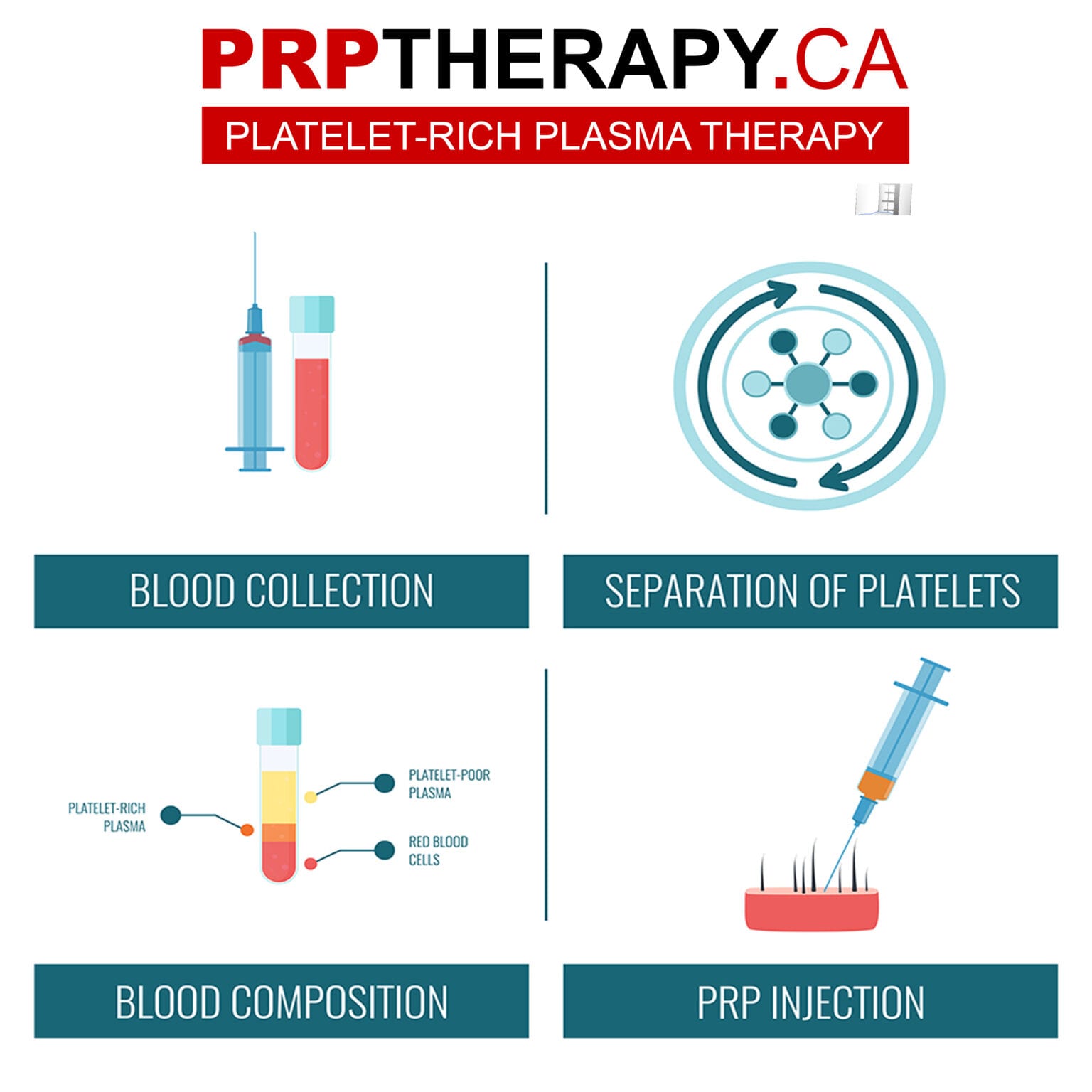
Cost of PRP Hair Treatment
Factors Impacting the Cost
Several factors can affect the cost of PRP hair treatment, including the doctor’snumber of sessions required, the doctor’s experience, the geographic location, and the area being treated. Some clinics offer treatment plans with multiple sessions, which can be a more cost-effective option for many patients.
Average Price Range
The cost of PRP hair treatment can vary widely but generally ranges from $500 to $1,000 per treatment session. While this may seem costly, many patients find the investment worthwhile for significantly improving hair quality and density. With any cosmetic procedure, it’s important to consider the long-term benefits and potential need for periodic maintenance treatments.
Comparison with Other Hair Loss Treatments
PRP vs Hair Transplant
Hair PRP treatment and hair transplant surgery are effective treatments for hair restoration, but they serve different purposes and have unique benefits.
- PRP Hair Treatment: This minimally invasive therapy relies on the three-step process of extracting, processing, and injecting platelet-rich plasma (PRP) to stimulate existing hair follicles and promote hair regrowth in areas of hair loss. It is ideal for patients with early-stage hair thinning or stress-related hair loss and those who prefer a non-surgical solution.
- Hair Transplants: Hair transplantation involves the surgical extraction of hair follicles from one area and implantation into bald or thinning regions. It is a more invasive procedure with a longer healing process but is suitable for individuals with advanced male pattern baldness or female pattern hair loss. The main reasons why some people prefer PRP over hair transplants include faster recovery time, lower cost, and reduced risk of complications.
PRP vs Topical Treatments
- Topical treatments like minoxidil are among the most popular methods for treating hair lopatient’sair. Treatment Uses the patient’s blood to naturally stimulate hair follicles with concentrated growth factors, adult stem cells, and cytokines. It has a positive effect on hair density and overall scalp health.
- Topical Treatments: These require daily application and are often effective for mild cases of androgenic alopecia. However, they may cause allergic reactions, and discontinuing their use usually results in losing regrown hair.
PRP hair treatment is more sustainable and holistic, especially with other alternative treatments.
PRP vs Laser Therapy
Laser therapy is another non-invasive hair restoration method gaining popularity.
- PRP Hair Treatment involves injecting a concentrated serum of platelets into specific areas of hair loss, directly targeting hair follicles for regrowth.
- Laser Therapy: Utilizes low-level lasers to stimulate cell growth and improve blood supply in the scalp. However, its effectiveness varies, usually requiring multiple sessions over several weeks.
PRP therapy often delivers quicker and more significant hair thickness results than laser therapy.
Clinical Studies
Evidence of Efficacy from Studies
Numerous clinical studies have validated the effectiveness of PRP injections in treating hair loss. Research published in sports medicine and cosmetic medicine journals highlights the following findings:
- Significant Increase in Hair Density: Studies have shown that PRP therapy significantly increases hair count, thickness, and density after multiple treatment sessions.
- Reduction in Hair Loss: Patients reported a noticeable reduction in hair shedding and improved overall scalp health after undergoing the PRP hair restoration.
Before and After PRP Hair Treatment
Clinical trials and case studies frequently show impressive before-and-after results of PRP hair treatments. For instance, a male patient with androgenic alopecia demonstrated a 30% increase in hair density after just four treatment sessions. Female patients with thinning hair also showed remarkable hair count and quality improvement.
Q&A
- How Many Sessions Are Required for PRP Treatment?
Typically, patients need between three to six PRP sessions, spaced 4-6 weeks apart, to attain optimal outcomes. Follow-up sessions may be needed every 6-12 months to maintain hair regrowth. Follow-up to maintain hair regrowth.
- How Long Does Each PRP Session Last?
A typical PRP session takes around an hour and includes a pre-procedure blood draw, centrifuge processing, and PRP injections.
- Is PRP Hair Treatment Permanent?
The effects of PRP hair treatment are not permanent. However, with regular maintenance sessions and good scalp care, patients can enjoy long-lasting benefits and hair restoration.
Conclusion: Is PRP Hair Treatment Worth It?
PRP hair treatment offers a safe, effective, and minimally invasive solution for people suffering from hair loss conditions like androgenic alopecia, female pattern hair loss, or a patient’s hair loss. Using the patient’s plasma, this three-step process stimulates hair follicles, improving hair density and quality with minimal risks.
With clinical evidence supporting its efficacy and high patient satisfaction rates, PRP hair therapy presents a promising and viable alternative to traditional hair restoration methods like topical treatments, laser therapy, and hair transplant surgery. Although not a permanent cure, it has a long history of success in promoting hair growth and maintaining scalp health.
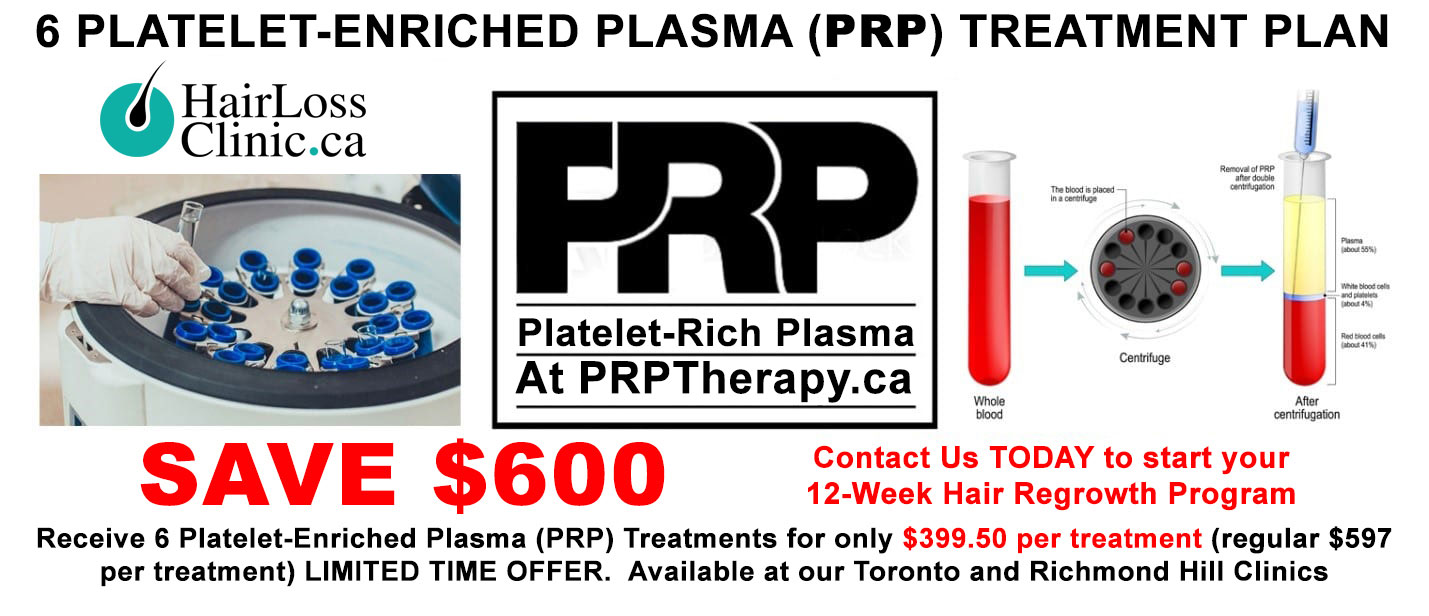
Working Hours
- Monday 10:00AM – 8:00PM
- Tuesday 10:00AM – 8:00PM
- Wednesday 10:00AM – 8:00PM
- Thursday 10:00AM – 8:00PM
- Friday 10:00AM – 8:00PM
- Saturday 10:00AM – 8:00PM
- Sunday - Closed
Quick Contacts
- 7549 Kalar Rd, Niagara Falls, L2H 2Y6
- Toronto: 600 Sherbourne St #605, Toronto, M4X 1W4
- Richmond Hill: 8763 Bayview Ave #5, Richmond Hill, L4B 3V1
- Mississauga: 1358 Hurontario St #B2, Mississauga, L5G 3H4
- Winnipeg: 712 St Mary's Rd, Winnipeg, MB R2M 3N1
- INFO@HAIRTATTOO.CA
- (647) 492-5022 Toronto GTA
- (204) 809-5885 Winnipeg
- 2023 HAIRTATTOO.CA | Scalp Micropigmentation & Trichology Centre




